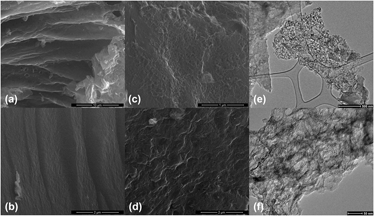Crossref Citations
This article has been cited by the following publications. This list is generated based on data provided by
Crossref.
Khan, Ayesha
Goepel, Michael
Colmenares, Juan Carlos
and
Gläser, Roger
2020.
Chitosan-Based N-Doped Carbon Materials for Electrocatalytic and Photocatalytic Applications.
ACS Sustainable Chemistry & Engineering,
Vol. 8,
Issue. 12,
p.
4708.
Kamedulski, Piotr
Zielinski, Wojciech
Nowak, Pawel
Lukaszewicz, Jerzy P.
and
Ilnicka, Anna
2020.
3D hierarchical porous hybrid nanostructure of carbon nanotubes and N-doped activated carbon.
Scientific Reports,
Vol. 10,
Issue. 1,
Ilnicka, Anna
Skorupska, Malgorzata
Romanowski, Piotr
Kamedulski, Piotr
and
Lukaszewicz, Jerzy P.
2020.
Improving the Performance of Zn-Air Batteries with N-Doped Electroexfoliated Graphene.
Materials,
Vol. 13,
Issue. 9,
p.
2115.
Zhu, Xiaofeng
Hu, Chuangang
Amal, Rose
Dai, Liming
and
Lu, Xunyu
2020.
Heteroatom-doped carbon catalysts for zinc–air batteries: progress, mechanism, and opportunities.
Energy & Environmental Science,
Vol. 13,
Issue. 12,
p.
4536.
Sukhbaatar, Bayaraa
Yoo, Bongyoung
and
Lim, Jae-Hong
2021.
Metal-free high-adsorption-capacity adsorbent derived from spent coffee grounds for methylene blue.
RSC Advances,
Vol. 11,
Issue. 9,
p.
5118.
Skorupska, Malgorzata
Ilnicka, Anna
and
Lukaszewicz, Jerzy P.
2021.
N-doped graphene foam obtained by microwave-assisted exfoliation of graphite.
Scientific Reports,
Vol. 11,
Issue. 1,
Skorupska, Malgorzata
Ilnicka, Anna
and
Lukaszewicz, Jerzy P.
2021.
The effect of nitrogen species on the catalytic properties of N-doped graphene.
Scientific Reports,
Vol. 11,
Issue. 1,
Skorupska, Malgorzata
Kamedulski, Piotr
Lukaszewicz, Jerzy P.
and
Ilnicka, Anna
2021.
The Improvement of Energy Storage Performance by Sucrose-Derived Carbon Foams via Incorporating Nitrogen Atoms.
Nanomaterials,
Vol. 11,
Issue. 3,
p.
760.
OKUDA, Ryunosuke
NAKANO, Kota
SUEMATSU, Koichi
WATANABE, Ken
ILNICKA, Anna
ŁUKASZEWICZ, Jerzy P.
and
SHIMANOE, Kengo
2021.
Chemical Activation of Nitrogen-doped Carbon Derived from Chitosan with ZnCl<sub>2</sub> to Produce a High-performance Gas Diffusion-type Oxygen Electrode.
Electrochemistry,
Vol. 89,
Issue. 1,
p.
36.
Ou, Changrui
Chen, Hui
Wang, Hou
Liao, Yalin
Li, Run
and
Liu, Hongbo
2021.
A novel in situ synthesis of nitrogen-doped graphene with excellent electrocatalytic performance for oxygen reduction reaction.
Electrochimica Acta,
Vol. 380,
Issue. ,
p.
138256.
Okuda, Ryunosuke
Suematsu, Koichi
Watanabe, Ken
and
Shimanoe, Kengo
2021.
Highly Porous Chitosan-derived Nitrogen-doped Carbon Applicable for High-performance Gas Diffusion Oxygen Electrodes.
Chemistry Letters,
Vol. 50,
Issue. 4,
p.
636.
Xu, Tao
Wang, Chunfeng
Han, Zhidong
and
Wang, Yongliang
2022.
Chitosan-derived N-doped porous carbon with enhanced nitrogen concentration and tailored nitrogen configuration.
Journal of Materials Science,
Vol. 57,
Issue. 19,
p.
8739.
Rupar, Jelena
Tekić, Danijela
Janošević Ležaić, Aleksandra
and
Upadhyay, Kush K.
2022.
ORR Catalysts Derived from Biopolymers.
Catalysts,
Vol. 13,
Issue. 1,
p.
80.
Sukhbaatar, Bayaraa
Yoon, Sanghwa
and
Yoo, Bongyoung
2022.
Simple synthesis of a CoO nanoparticle-decorated nitrogen-doped carbon catalyst from spent coffee grounds for alkaline hydrogen evolution.
Journal of Materials Science,
Vol. 57,
Issue. 38,
p.
18075.
Tachibana, Naoki
Kanai, Minoru
Kamezaki, Yu
and
Somekawa, Shoichi
2022.
Enhanced nitrogen doping in porous carbon and its composite with MnO2 as an efficient oxygen reduction catalyst for Mg–air batteries.
Journal of Materials Science,
Vol. 57,
Issue. 33,
p.
15929.
Yuasa, Masayoshi
Koga, Yuki
Ueda, Hazuki
and
Zayasu, Tomonari
2022.
Effect of hydrothermal treatment and LaMnO3 loading on the oxygen reduction activity of chitosan-derived carbon-based gas diffusion electrodes.
Journal of Applied Electrochemistry,
Vol. 52,
Issue. 8,
p.
1173.
Skorupska, Malgorzata
Ilnicka, Anna
and
Lukaszewicz, Jerzy P.
2022.
Successful Manufacturing Protocols of N-Rich Carbon Electrodes Ensuring High ORR Activity: A Review.
Processes,
Vol. 10,
Issue. 4,
p.
643.
Abushawish, Alaa
Almanassra, Ismail W.
Backer, Sumina Namboorimadathil
Jaber, Lubna
Khalil, Abdelrahman K.A.
Abdelkareem, Mohammad Ali
Sayed, Enas Taha
Alawadhi, Hussain
Shanableh, Abdallah
and
Atieh, Muataz Ali
2022.
High-efficiency removal of hexavalent chromium from contaminated water using nitrogen-doped activated carbon: kinetics and isotherm study.
Materials Chemistry and Physics,
Vol. 291,
Issue. ,
p.
126758.
Bumajdad, Ali
Khan, Mohammad Jakir Hossain
and
Lukaszewicz, Jerzy P.
2023.
Nitrogen-enriched activated carbon derived from plant biomasses: a review on reaction mechanism and applications in wastewater treatment.
Frontiers in Materials,
Vol. 10,
Issue. ,
Fan, Zhixuan
Feng, Tao
Wu, Si
Wang, Shuai
Tan, Yi
Yu, Qinghong
Huang, Ranran
and
Zhang, Xinyue
2023.
Chitin-derived biochar with nitrogen doping to activate persulfate for phenol degradation: Application potential and electron transfer pathway in system.
Chemosphere,
Vol. 330,
Issue. ,
p.
138641.





